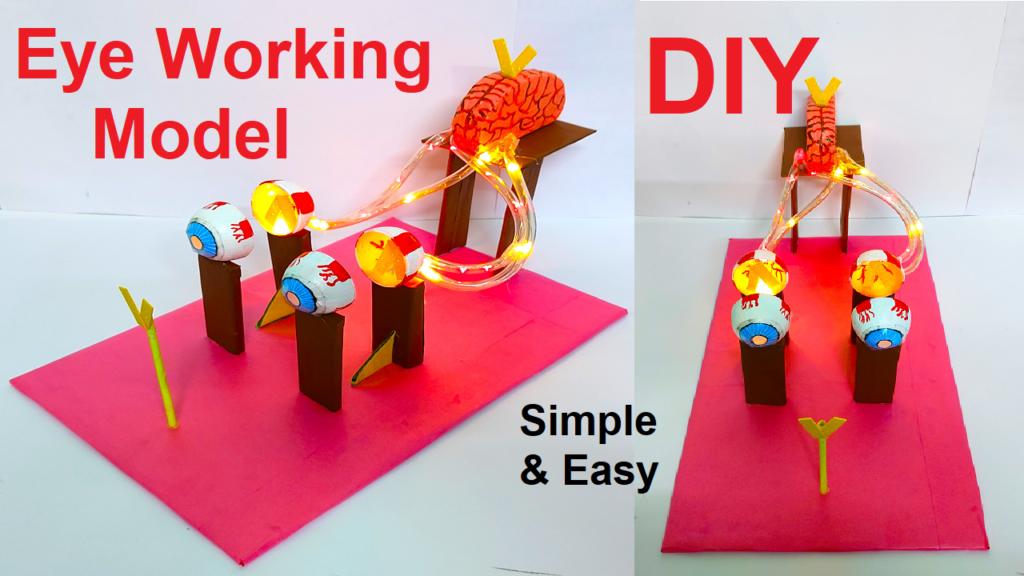1. Introduction
The human eye is one of the most complex and important sense organs. It allows us to perceive the world through the sense of vision. Almost 80% of all information we receive comes through our eyes.

The eye works like a natural camera, capturing light and converting it into signals that the brain interprets. Its study involves biology (structure), physics (optics), and health science (care).
2. Structure of Human Eye

The human eye is a spherical organ, approximately 2.5 cm in diameter, located in the eye socket (orbit) and protected by eyelids, eyelashes, and tear glands.
Major parts of the eye:
- Cornea – Transparent, curved front surface that refracts light.
- Pupil – Opening in the center of the iris that controls light entry.
- Iris – Colored part of the eye; regulates pupil size.
- Lens – Transparent, flexible structure that focuses light on retina.
- Retina – Inner light-sensitive layer containing rods and cones.
- Aqueous Humor – Fluid between cornea and lens.
- Vitreous Humor – Gel-like fluid inside eyeball that maintains shape.
- Optic Nerve – Transmits visual signals to the brain.
- Sclera – White, protective outer covering.
- Choroid – Middle layer with blood vessels to supply nutrients.
3. Working of the Eye

The eye functions by refracting light rays from an object and focusing them onto the retina:
- Light enters through the cornea.
- Pupil regulates the amount of light.
- Lens bends light rays to form an image.
- Retina captures the image (inverted and real).
- Optic nerve carries the information to the brain.
- The brain processes and interprets the image upright.
4. Function of Different Parts
- Cornea: First refracting surface.
- Lens: Fine adjustment of focus.
- Iris and Pupil: Light regulation.
- Retina: Converts light into nerve signals.
- Rods: Night vision (black & white).
- Cones: Day vision (color).
- Optic Nerve: Signal transmission.
5. Power of Accommodation
The eye lens changes its focal length to focus objects at different distances:
- Near point (Least distance of distinct vision): ~25 cm.
- Far point: Infinity.
- Accommodation: The ability of the eye lens to adjust its curvature using ciliary muscles to see objects clearly at different distances.
6. Common Defects of Vision
- Myopia (Near-sightedness):
- Distant objects appear blurred.
- Cause: Eyeball too long or lens too curved.
- Correction: Concave lens.
- Hypermetropia (Far-sightedness):
- Near objects appear blurred.
- Cause: Eyeball too short or lens too flat.
- Correction: Convex lens.
- Presbyopia:
- Age-related defect; difficulty in near vision.
- Cause: Weakening of ciliary muscles.
- Correction: Bifocal/Progressive lenses.
- Astigmatism:
- Distorted vision due to irregular cornea.
- Correction: Cylindrical lenses.
- Cataract:
- Clouding of lens leading to blindness.
- Cure: Surgery and lens replacement.
7. Correction of Defects (Use of Lenses)
- Concave lenses correct myopia by diverging light.
- Convex lenses correct hypermetropia by converging light.
- Bifocal lenses correct presbyopia.
- Cylindrical lenses correct astigmatism.
8. Human Eye vs. Camera
The human eye functions like a camera:
| Eye | Camera |
|---|---|
| Cornea + Lens | Camera Lens |
| Retina | Photographic Film/Sensor |
| Iris | Aperture |
| Ciliary Muscles | Autofocus system |
| Optic Nerve | Data cable to processor |
9. Role of Brain in Vision
The eye only captures the image; the brain interprets it. The optic nerve transmits inverted images from the retina, and the visual cortex of the brain flips and processes them to give a correct perception.
10. Eye Care and Hygiene
- Wash eyes regularly.
- Avoid prolonged screen time.
- Use protective glasses in strong sunlight.
- Eat Vitamin A-rich foods (carrots, spinach, papaya, fish oil).
- Regular eye check-ups.
11. Interesting Facts about Human Eye
- Human eye can differentiate about 10 million colors.
- Eye blinks ~15–20 times per minute.
- Retina has about 120 million rods and 6 million cones.
- The eye lens is the only part of the body without blood supply.
12. Importance of Vision in Daily Life
Vision is crucial for:
- Reading and learning.
- Driving and working.
- Social interaction.
- Safety and survival.
- Artistic and cultural appreciation.
13. Impact of Technology on Eye Health
- Excessive screen use leads to Computer Vision Syndrome (CVS).
- Blue light causes eye strain, headaches, and sleep problems.
- Mobile and laptop overuse increases risk of myopia in children.
14. Preventive Measures for Healthy Eyes
- Follow 20-20-20 rule: Every 20 minutes, look at something 20 feet away for 20 seconds.
- Maintain balanced diet with Vitamin A, C, E, and Omega-3.
- Use correct posture and lighting while reading.
- Limit screen exposure.
15. Modern Research and Advancements
- LASIK surgery for permanent correction of vision.
- Bionic eyes (artificial retinas) to restore partial sight to blind people.
- Stem cell therapy for damaged retinal cells.
- Smart contact lenses being developed to monitor glucose levels in diabetic patients.
16. Conclusion
The human eye is a remarkable natural organ that enables us to see and interpret the world. Its functioning is a combination of biology and physics. While defects of vision are common, science and technology provide effective solutions like lenses, surgeries, and even artificial eyes.
This project taught me that taking care of our eyes is as important as caring for any other organ. With proper nutrition, eye care, and responsible use of technology, we can preserve our vision for life.
17. Bibliography
- NCERT Science Textbooks – Class 8–10 (Light and Human Eye chapters)
- NCERT Biology Textbook – Class 11 & 12 (Anatomy of Eye, Nervous System)
- Fundamentals of Physics by Resnick, Halliday & Walker
- World Health Organization (WHO) – Eye Health Reports
- Websites: American Academy of Ophthalmology, Khan Academy Biology

